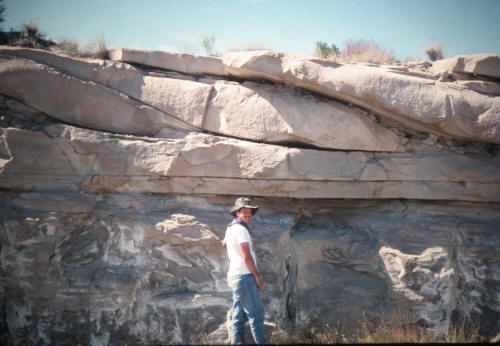Day 4, Stop 1
Curtis Formation Stop
Location:
West flank San Rafael Swell on I-70, north side of interstate.
Ages:
Upper Jurassic
Rock Units:
Curtis Formation, upper San Rafael Group
Features Present:
Depositional Environment:
Tidal, nearshore
Interpretation:
Sigmoidal bundles and the regular alternating rhythmites are attributed to tidal processes. Channelized tidal flow has distinct slack-water periods that result in mud drapes like these in the Curtis Formation. Curtis tidal bundles display cyclicity that is interpreted to be in response to the lunar month, neap/spring tide fluctuations. The most complete and well-defined bundles occur during the spring phase while neap-tide bundles are less well developed. Kreisa and Moiola (1986) reported on 28 bundles with cyclic variation in thickness and sedimentary structures. They noted that foresets developed during maximum flow of spring tides dip 25o to 28o, but neap-tide foresets are more gently inclined (12o to 25o). Accelerating tidal currents caused the foreset lamination of bundles to steepen. Curtis sigmoid and other laterally accreted tidal bundles are believed to have formed within channels or at the margins of bars (Kreisa & Moiola, 1986). Figure 3 is repeatedly alternating sand (some with ripple cross lamination) and mud rich beds on a scale of a few centimeters. Kreisa and Moiola (1986) interpret these features as having formed in very shallow water (probably intertidal); the flat bedded intervals formed in maximum tidal flow velocities, and the


Figure 1: Figure 1B, A model of internal sedimentary structures pictured in Figure 1A:
1 - A thin basal bed plus overlying, gently dipping laminations, interpreted as ACCELERATION PHASE.
2 - Topset laminations passing over a brinkpoint to foreset laminations, MAXIMUM VELOCITY.
3 - Sigmoidally curved parallel lamination, DECELERATION PHASE.

Figure 2: (T) = topset lamination, (F) = foreset lamination, (B) = brinkpoint, (S) = sigmoidal laminations, (P) = pause plane (Kreisa & Moiola, 1986).

Figure 3: Tidal rhythmites, alternating layers of mud vs. sand rich coupled sets.
